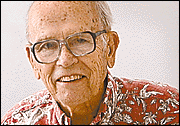


Hawaii’s World
ALAN Hayashi, executive director of the Hawaii Convention Center Authority for the last 10 years, regularly told me the new center was going up "on schedule, on budget." Now he can add: "On target." Convention center
might- have-beensThe center passed its biggest test when the American Dental Association jammed it to capacity in early October, then pronounced it one of its best meeting sites ever. Members passed a resolution favoring informal garb, if not aloha shirts, at all future gatherings. They hardly will be likely, however, to match our indoor-outdoor ambience elsewhere.
After the triumph, I asked Hayashi to review the "might-have-been" sites passed over en route to the final selection: Fort Armstrong, Fort DeRussy, the International Market Place, Ala Wai Golf Course at the Diamond Head end, Ala Wai Golf Course near Iolani School and Hobron Lane across the Ala Wai Canal from the chosen site.
Fort DeRussy would have been the best and was available, Hayashi said, but was shouted down for congestion reasons by Waikiki residents organized by former legislator Mary-Jane McMurdo.
That center would have been built at the parade ground, probably mostly underground with a park on top, somewhat like Moscone Center in San Francisco. It was the site most accessible to visitors. In blue-sky thinking, it might have been possible to connect it with the unfinished off ramp at Lunalilo Freeway via tunnels under Ala Wai Canal and under Waikiki.
The present site probably beats all the others, if only because the Ala Wai Golf Course near Iolani School would have been tied up in litigation by advocates of the present site, and the Hobron site might similarly have been fought in the courts by residents of the area.
The golf course site near Iolani would have had to be elevated because of flood potential. Access for hotel guests might have been via a controversial bridge over the Ala Wai. The golf course site near Diamond Head would have faced traffic problems and resident complaints.
Early on, the International Market Place was actually chosen as the site. Japanese investors were interested in building there, cost-free to the public, in exchange for rights to intensive hotel, condominium, commercial and office development around it.
In print I described that plan as more appropriate for a Donald Trump complex in midtown Manhattan than for Hawaii. Gulf War tourism slides and financial problems back home ended the Japanese investor interest.
FORT Armstrong was judged too far from Waikiki. Neighbor Island locales fell out for both remoteness and inadequacy of a hotel room supply and labor force. Kailua-Kona in particular still might profit from a conference center.
The Atkinson site cost $130 million to buy and $200 million to build under a design-build contract in which construction and design teams competed to build at the $200 million price.
Two separate review panels praised and recommended the winning design proposal by a Seattle firm experienced in convention center construction and the Hawaii architectural firm of Wimberly, Allison, Tong and Goo, the world leader in resort design.
Hayashi, who comes from a construction firm background, gives immense credit to the constant monitoring of the project builders by architect Charles "Ty" Sutton, the authority's overseer. He also thanks his authority members.
Hayashi now foresees a gradual upgrading of properties around the Atkinson site just as the area surrounding San Francisco's Moscone Center has been upgraded.
A.A. Smyser is the contributing editor
and former editor of the the Star-Bulletin
His column runs Tuesday and Thursday.